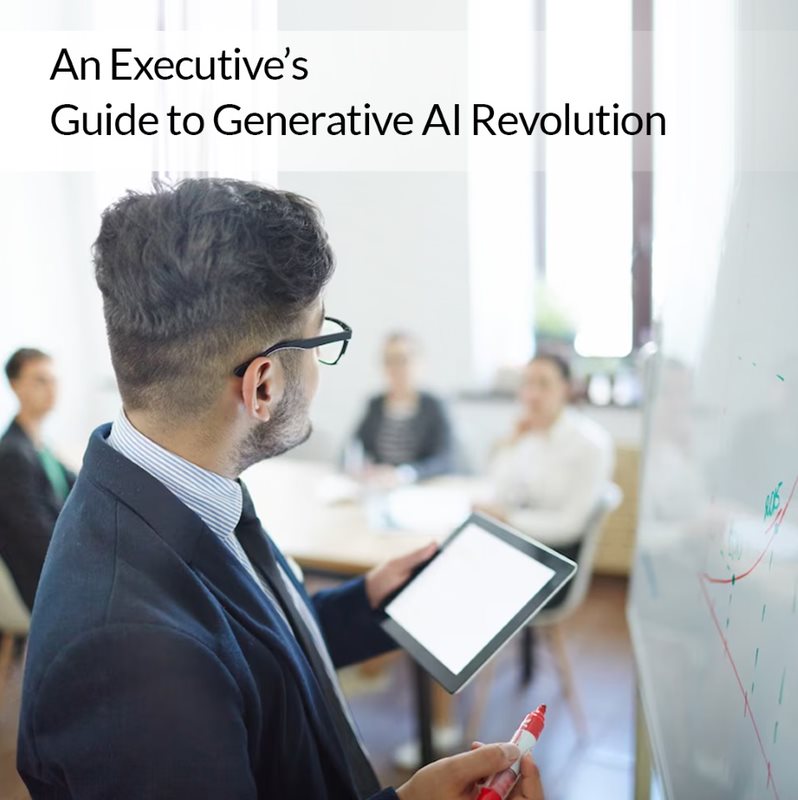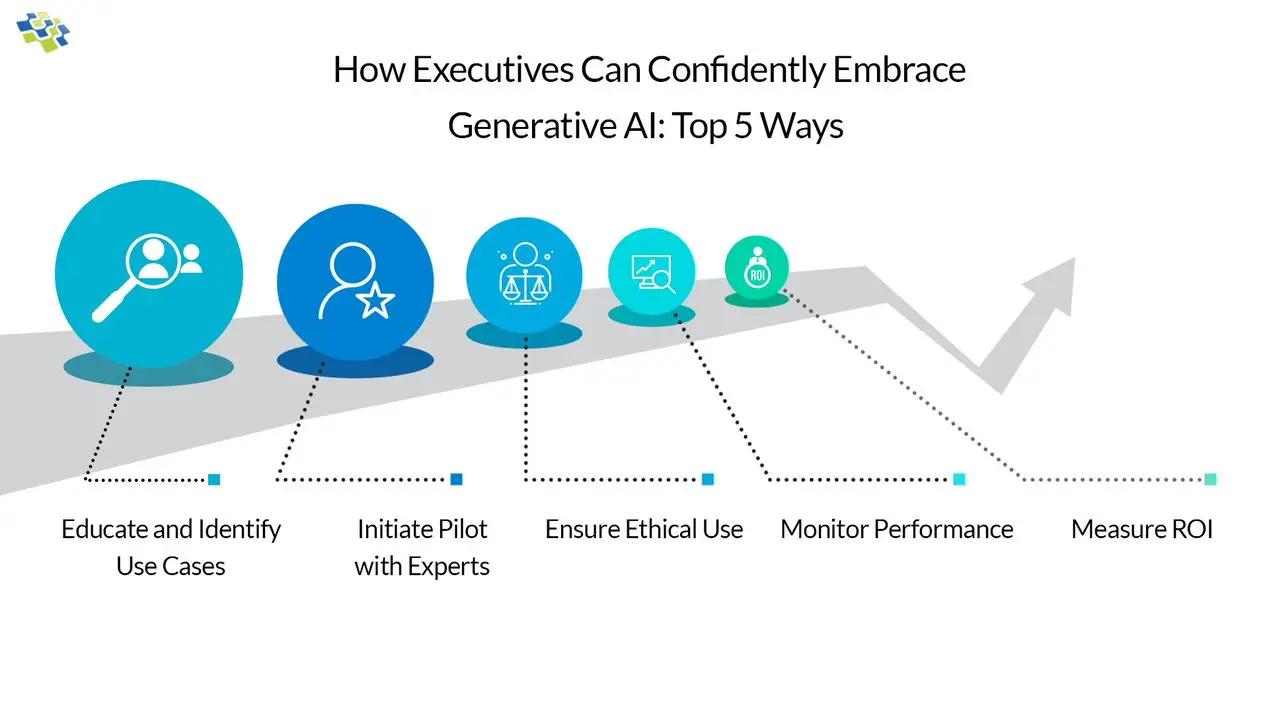An Executive’s Guide to Generative AI Revolution
The gravity of such decisions necessitates astute judgment, a quality uniquely possessed or facilitated by the executive. Moreover, these choices must align harmoniously with the objectives, encompassing the definition of the company’s mission and values.

“According to the esteemed National Venture Capital Association (NVCA), the Generative AI revolution constituted a mere fraction, specifically less than 1%, of the colossal $238.3 billion encompassing the entire spectrum of venture capital (VC) funding in the United States throughout 2022.”- Business Insider
Generative AI Revolution
The Generative AI revolution poses a significant challenge for executives, as its potential for business-model innovation and industry disruption cannot be overlooked. Just as Mosaic revolutionized the internet era, Generative AI holds the power to deliver competitive advantage and creative destruction across diverse sectors. Executives must embrace a Generative AI strategy, moving beyond current endeavors for sustainable growth.
Executives may find themselves uncertain about the path ahead, given the complexity of embracing Generative AI and their relative distance from the technology itself. However, we believe that their focus should lie on understanding the impact of Generative AI revolution on their organizations and industries, rather than becoming deeply immersed in the technical details. The key for executives is to identify strategic decisions that enable them to leverage the opportunities and mitigate the risks that Generative AI presents. These decisions can be guided by three fundamental pillars: Potential, People, and Policies.
Undoubtedly, the domain of Generative AI is rapidly advancing, and the pillars mentioned above necessitate careful deliberation of both short- and long-term implications, alongside addressing various other unresolved matters. Executives must prepare for a future where their existing business models may become obsolete, requiring proactive measures to stay ahead of the curve.
How Executives Can Confidently Embrace Generative AI: Top 5 Ways
By adopting the following five tactics, executives may confidently embrace Generative AI:

1. Educate & Identify Use Cases
Executives must gain a thorough understanding of Generative AI technology and its applications to fully realize the potential of this technology. To do this, one must become intimately familiar with the numerous Generative AI model types and investigate the wide variety of application scenarios. To do this, executives must thoroughly examine every step of their company’s operational processes to pinpoint the areas in which Generative AI might be highly advantageous. By thoroughly examining these operational procedures, executives can uncover opportunities where Generative AI can be leveraged to drive innovation, enhance customer experiences, streamline processes, and optimize business outcomes. Through this proactive approach, executives can effectively embrace Generative AI and position their organizations for success in the rapidly evolving landscape of artificial intelligence.
2. Initiate Pilot with Experts
Executives should follow a progressive strategy by starting small-scale pilot initiatives to successfully integrate Generative AI into their business operations. They may evaluate the efficacy of Generative AI in tackling business challenges or possibilities thanks to these pilot programs, which act as invaluable testing grounds. They can find out whether there are any potential barriers and limitations that could prevent wider implementation by beginning with these modest projects. Executives should collaborate with experienced Generative AI professionals who possess a deep understanding of technology. These professionals can provide guidance, support, and expertise throughout the implementation process, helping executives navigate the intricacies of Generative AI and ensuring a smooth transition to larger-scale deployment. Through this iterative approach, executives can refine their understanding of Generative AI and make informed decisions regarding its wider adoption within their organization.
3. Ensure Ethical Use
As executives adopt Generative AI, it is crucial that they give ethical issues a top priority and make sure that its use adheres to the values and ideals of their company. A Generative AI system that adheres to ethical standards must protect privacy, guarantee data security, and minimize any biases. Executives should develop precise rules and regulations that control how data is gathered, stored, and used in Generative AI systems. It is essential to be transparent about how Generative AI functions and any potential effects it may have on people and society. It is important to regularly audit and examine Generative AI applications to assess their ethical consequences. Additionally, executives should foster a culture of responsibility and accountability within their organization, encouraging employees to consider ethical implications when developing and deploying Generative AI solutions. By upholding ethical standards, executives can build trust with customers, employees, and stakeholders while harnessing the transformative power of Generative AI.
4. Monitor Performance
Executives must build reliable monitoring tools to evaluate their performance and ensure alignment with expected outcomes to use Generative AI models effectively. They can spot any deviations, irregularities, or problems that can appear while deploying Generative AI models thanks to continuous monitoring. They may ensure that the models produce the desired results by regularly monitoring performance metrics and taking aggressive measures to remedy any flaws or inaccuracies. Regular assessments of key performance metrics, evaluations of the quality of the data, and feedback loops with end users should all be a part of this monitoring process. Executives can make wise judgments, iterate on changes, and maximize the value gained from this technology by carefully monitoring Generative AI models.
5. Measure ROI
Executives must calculate the return on investment (ROI) linked to Generative AI projects to evaluate their worth and profitability. The benefits and results produced compared to the investments made are quantified via ROI evaluation. To monitor the effects of Generative AI projects on multiple factors like revenue growth, cost savings, process efficiency, customer happiness, or innovation, executives need to develop unambiguous metrics and key performance indicators (KPIs). Executives can effectively assess the performance of Generative AI implementations, make educated decisions regarding future investments, and justifiably allocate resources to further utilize the potential of Generative AI within their organizations by conducting extensive ROI assessments.
Further Read: A Tale of Two Billionaires: Elon Musk and Bill Gates’ Generative AI Views
Wrapping Up
In conclusion, the Generative AI revolution presents a remarkable opportunity for executives to drive innovation, enhance customer experiences, and transform their organizations. Executives can navigate this transformative technology with confidence if they understand the potential impact, assess risks, and stay on top of the latest developments.
As your organization embarks on this journey, it is crucial to have a trusted partner by your side. At NextGen Invent, we embrace the power of Generative AI and leveraging it to build innovative solutions for our clients. Whether you need assistance in integrating Generative AI into your existing systems or creating bespoke applications that harness its capabilities, our team of experts is ready to guide you every step of the way.
Don’t miss the immense opportunities presented by the Generative AI revolution.
Contact us today and let us help you unlock the full potential of this groundbreaking technology for your organization. Together, we can shape a future where innovation knows no bounds.
Further read: How Artificial Intelligence (AI) Is Impacting Supply Chain Management?
Stay In the Know
Get Latest updates and industry insights every month.

